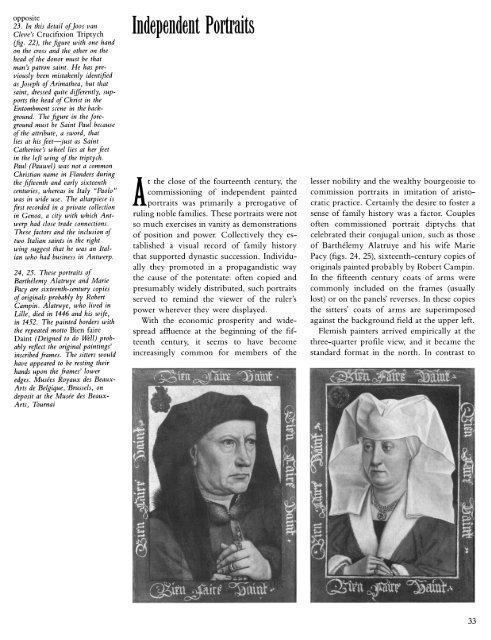Early Flemish Portraits 1425-1525: The Metropolitan Museum of Art ...
Early Flemish Portraits 1425-1525: The Metropolitan Museum of Art ...
Early Flemish Portraits 1425-1525: The Metropolitan Museum of Art ...
Create successful ePaper yourself
Turn your PDF publications into a flip-book with our unique Google optimized e-Paper software.
opposite<br />
23. In this detail <strong>of</strong>Joos van<br />
Cleve's Crucifixion Triptych<br />
(fig. 22), the figure with one hand<br />
on the cross and the other on the<br />
head <strong>of</strong> the donor must be that<br />
man's patron saint. He has previously<br />
been mistakenly identified<br />
as Joseph <strong>of</strong> Arimathea, but that<br />
saint, dressed quite differently, supports<br />
the head <strong>of</strong> Christ in the<br />
Entombment scene in the background.<br />
<strong>The</strong> figure in the foreground<br />
must be Saint Paul because<br />
<strong>of</strong> the attribute, a sword, that<br />
lies at his feet-just as Saint<br />
Catherine's wheel lies at her feet<br />
in the left wing <strong>of</strong> the triptych.<br />
Paul (Pauwel) was not a common<br />
Christian name in Flanders during<br />
the fifteenth and early sixteenth<br />
centuries, whereas in Italy "Paolo"<br />
was in wide use. <strong>The</strong> altarpiece is<br />
first recorded in a private collection<br />
in Genoa, a city with which Antwerp<br />
had close trade connections.<br />
<strong>The</strong>se factors and the inclusion <strong>of</strong><br />
two Italian saints in the right<br />
wing suggest that he was an Italian<br />
who had business in Antwerp.<br />
24, 25. <strong>The</strong>se portraits <strong>of</strong><br />
Barthelemy Alatruye and Marie<br />
Pacy are sixteenth-century copies<br />
<strong>of</strong> originals probably by Robert<br />
Campin. Alatruye, who lived in<br />
Lille, died in 1446 and his wife,<br />
in 1452. <strong>The</strong> painted borders with<br />
the repeated motto Bien faire<br />
Daint (Deigned to do Well) probably<br />
reflect the original paintings'<br />
inscribed frames. <strong>The</strong> sitters would<br />
have appeared to be resting their<br />
hands upon the frames' lower<br />
edges. Musees Royaux des Beaux-<br />
<strong>Art</strong>s de Belgique, 'Brussels, on<br />
deposit at the Musee des Beaux-<br />
<strong>Art</strong>s, Tournai<br />
Independent<br />
<strong>Portraits</strong><br />
t the close <strong>of</strong> the fourteenth century, the<br />
commissioning <strong>of</strong> independent painted<br />
portraits was primarily a prerogative <strong>of</strong><br />
ruling noble families. <strong>The</strong>se portraits were not<br />
so much exercises in vanity as demonstrations<br />
<strong>of</strong> position and power. Collectively they established<br />
a visual record <strong>of</strong> family history<br />
that supported dynastic succession. Individu-<br />
ally they promoted in a propagandistic way<br />
the cause <strong>of</strong> the potentate: <strong>of</strong>ten copied and<br />
presumably widely distributed, such portraits<br />
served to remind the viewer <strong>of</strong> the ruler's<br />
power wherever they were displayed.<br />
With the economic prosperity and widespread<br />
affluence at the beginning <strong>of</strong> the fifteenth<br />
century, it seems to have become<br />
increasingly common for members <strong>of</strong> the<br />
lesser nobility and the wealthy bourgeoisie to<br />
commission portraits in imitation <strong>of</strong> aristocratic<br />
practice. Certainly the desire to foster a<br />
sense <strong>of</strong> family history was a factor. Couples<br />
<strong>of</strong>ten commissioned portrait diptychs that<br />
celebrated their conjugal union, such as those<br />
<strong>of</strong> Barthelemy Alatruye and his wife Marie<br />
Pacy (figs. 24, 25), sixteenth-century copies <strong>of</strong><br />
originals painted probably by Robert Campin.<br />
In the fifteenth century coats <strong>of</strong> arms were<br />
commonly included on the frames (usually<br />
lost) or on the panels' reverses. In these copies<br />
the sitters' coats <strong>of</strong> arms are superimposed<br />
against the background field at the upper left.<br />
<strong>Flemish</strong> painters arrived empirically at the<br />
three-quarter pr<strong>of</strong>ile view, and it became the<br />
standard format in the north. In contrast to<br />
33

















